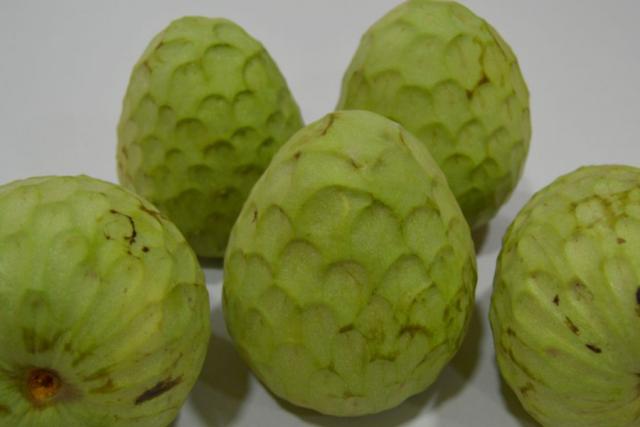South America, more precisely on the Andean border between Ecuador and Peru, and the tree grows at altitudes between 1.400 and 2.000 m.
Description and Characteristics:
The custard apple (Annona cherimola Mill) belongs to the Annonaceae family. The first Spanish explorers introduced this fruit tree to the East via Africa. The custard apple can currently be found in almost all countries with a tropical climate. In Spain it is only grown in Andalusia occupying about 3300 hectares.
It is a small tree up to 8 m high, with a short trunk and more or less rounded broad crown, with lower branches forming "skirts". Young branches are covered with a mat of gray hair that often has a rusty color. The root system is shallow and branched out, with two or three different levels, although they are not deep. It is a deciduous tree, but in areas with mild winters it is evergreen or at least keeps the leaves until the following spring. The leaves are oval and alternate, with a short stalk and regular vein system, coated on the underside with visible hair.
The flowers can be single or grouped in numbers of 2 to 3 in the axils of the leaves of the previous year, and until the leaf falls the bud cannot develop (it is protected by the leaf stalk). They have three very pulpous petals that are a green cream colour and unattractive. The fruit is a berry with numerous black seeds, that are ovoid and glossy. This green coloured infructescence is heart-shaped or rounded and the surface of its skin has slightly flattened out bumps and when ripe it changes to a lighter green color or white. Its pulp is fleshy, creamy, juicy, white, very sweet and tender. If the egg is not fertilized, the corresponding carpel tends not to develop, so that the fruit grows deformed.
The custard apple varieties grown on the Costa Tropical come exclusively from varieties native to the Coast of Granada; 95 % are of the Fino de Jete variety, and the other 5% the Campas variety. The Fino de Jete variety, which is the most important, is a clonal selection (multiplied by agamic propogation, by grafting) carried out by farmers of the Río Verde Valley since the early twentieth Century, from various genotypes obtained from seeds, which were plentiful in this area. The selection was carried out by farmers, taking into account the quality of the product (sweet taste) and the smooth skin, which helped its commercialization.
As for its climatic needs, the custard apple is not frost hardy and temperatures above 30ºC will inhibit its growth.
One of its peculiarities of this crop is the need for manual pollination, thus ensuring a minimum harvest of the fruit each year, of a heavier weight and better shaped.
NUTRITIONAL VALUE
The custard apple has a high water and carbohydrate content such as glucose and fructose; however it is low in fat and protein. But due to its high sugar content, its calorific value is quiet high. As for other nutrients, it is a good source of potassium and vitamin C. Amongst the beneficial properties from its consumption, this fruit is very digestible, remineralizing, laxative and regulates the blood sugar level and is a good antioxidant with vitamins C and A.
Areas where the custard apple is grown in Motril:
Hillsides of Minasierra, Panata, Montecastillo, Galindo and higher hillsides around Puntalón. At present there are about 565 hectares of custard apple.

